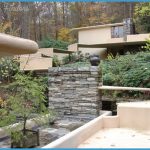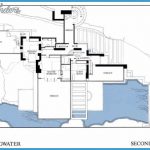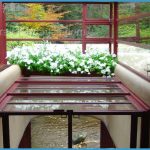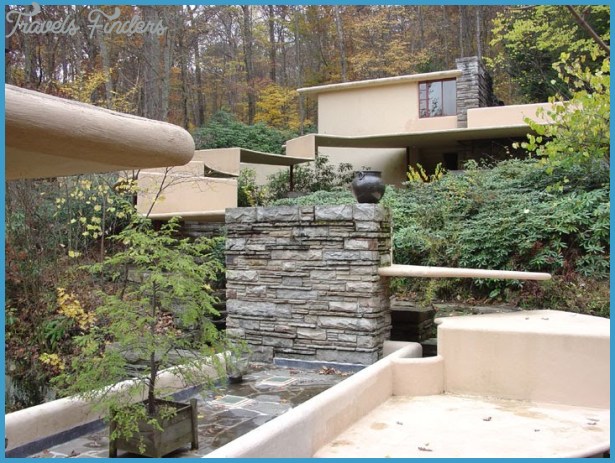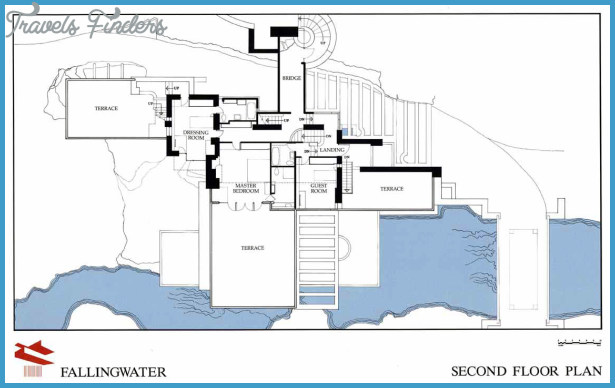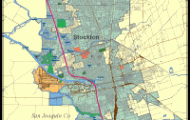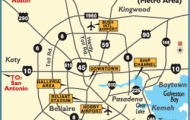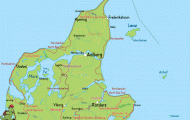FRANK LLOYD WRIGHT
The American architect Frank Lloyd Wright created some of the most memorable and striking houses of the 20th century and Fallingwater, which he designed for Edgar Kaufmann, a wealthy department-store owner, is the most famous of them all. Built on a rock ledge right above a waterfall in the wooded countryside southeast of Pittsburgh, Pennsylvania, Fallingwater features dramatic, jutting balconies and big expanses of glass. The way in which its stone walls and concrete balconies emerge from the woodland setting and appear to float above the mountain stream creates a unique marriage of architecture and site.
Neither Kaufmann nor his building contractor were confident that the structure of the house would be stable, and the construction was plagued with disputes between Wright, his client, and the builders. The cantilevered jutting) balconies were the most challenging element of the design, and the builders had to strengthen them with additional steelwork, but this made them heavier than Wright had originally intended them to be and probably contributed to a slight sagging.
The resulting house was, however, spectacular. A huge, stone-floored living room offered plenty of space for sitting and eating. On one side of this room Wright built a stone hearth around an existing boulder-at the very spot at the edge of the waterfall where the Kaufmann family used to picnic. The broad windows of the living room and bedrooms look out onto stunning views of the trees surrounding the house, and the generous balconies-two connected to the living room, two more to the bedrooms, and a fifth to the gallery at the top of the house-invite family and guests to step outside. This skillful linking of the interior and exterior, together with the way in which the house itself seems to form part of the waterfall and woodland, is perhaps the ultimate example of what Wright called “organic architecture.
FRANK LLOYD WRIGHT
1867-1959
Initially trained as an engineer, Wisconsin-born Frank Lloyd Wright worked for various architects, including Louis Sullivan, the great designer of early skyscrapers, before setting up his own practice. Based in Chicago, Wright made his name designing large, low-slung houses for wealthy clients, as well as his own homes, Taliesin in Wisconsin and Taliesin West in Arizona. He went on to design larger buildings, such as Tokyo’s Imperial Hotel and the 1936 corporate headquarters for Johnson Wax in Racine, Wisconsin, known for its innovative interior columns. A series of less-costly houses in the 1930s brought Wright’s design ideas to a wider clientele, and after World War II he continued to experiment, designing New York’s Guggenheim Museum, with its unique spiral ramp. Such spectacular buildings made Wright one of the most influential architects of the 20th century.
Visual tour: exterior
The gallery at the top provides the best viewpoint
The living room windows look out onto the trees
The main bedrooms are on this floor
1 TRAYLIKE BALCONIES Appearing to float above the falls, these solid concrete balconies are cantilevered (project outward from their visible means of support). They are in fact balanced on reinforced concrete beams and steelwork that is anchored firmly to the bedrock beneath the house. Fallingwater’s main balconies appear particularly large because they jut out so far from the core structure.
4 EXTERIOR STAIRS
Steps made from various materials, including natural stone, run up the sides of the house, linking the building both to the nearby guesthouse and the stream. The stone for the house came from the small quarry near the building site, which had been reopened by Wright. As a result there is perfect harmony between the rocks on which the house stands, the masonry that rises up from them to form the core of the building, and other stone features.
The waterfall is on Bear Run, a mountain stream
2 GLASS AND STEEL Few of the rooms in the house have conventional window frames. The panes of glass are held between horizontal red metal glazing bars and run right up to the walls and into a caulked (waterproofed) gap between the stones. Wright liked the way in which a fragile material such as glass could butt up against rough, rugged stone, creating an unusual contrast in texture. By using window frames without edges, he could also maximize the amount of natural light coming into the house.
ON DESIGN
A famous story tells how Kaufmann called Wright to say he was on his way to the architect’s office later that day. Wright, who had still not done any drawings for Fallingwater, his client’s new house, duly produced drawings in a couple of hours. Although the initial drawings may have been produced quickly, the actual design of the house evolved over a lengthy period of time, with various stages of preliminary and more final drawings. Toward the end of this process, Wright, who loved to make elegant perspective drawings of his buildings, often influenced by the Japanese graphics he liked, created his most famous image of the house (below). This shows Fallingwater from a low viewpoint, its balconies stretching out above a sheer curtain of water.
1 Fallingwater
The perspective in Wright’s drawing, made from below the falls, exaggerates the size and cantilevering of the balconies.
IN CONTEXT
In the early years of the 20th century Wright designed a series of houses for rich clients in the midwest. Inspired by the wide open, flat landscape of the prairies, these buildings, known as Prairie houses, were large and ground-hugging, often with generously overhanging roofs and long, horizontal strips of windows. They tended to be on a cross-shaped plan, focused on a central hearth, and featured innovative details such as built-in furniture. Natural materials, especially plain wood, dominated, and the big reception rooms had porches or terraces, blurring the boundary between the interior and exterior. The Prairie houses established Wright as one of the leading architects of his time and redefined American domestic architecture.
1 The Robie House
Completed in 1910, this Chicago home, built by Wright in the Prairie style, is a striking forerunner of Modernist architecture.
2 GUEST HOUSE Linked to the main house by a curving path are a guest house, where the Kaufmanns’ servants lived, and a car port. Built two years after Fallingwater, these were constructed to the same specifications and with similar materials. Wright made sure that water such an important presence in the main house was also a feature of the guest house by incorporating a swimming pool, fed by a spring, which overflowed into the river.
Visual tour: interior
4 LIVING ROOM The huge living room shimmers with light from the wide row of windows running along its southern side. When opened, these let in the sound of the waterfall below. The natural stone-flagged floor and exposed stone walls harmonize with the rocks outside, while the plain ceiling is a neutral off-white in color. The living room is large enough to contain several groups of seats one by the windows, another near the hearth (to the right in the photograph), and a seating area in a music alcove.
3 DINING AREA Above the dining table, which is set at one end of the large living room, rises a stone pillar punctuated by a series of red wooden shelves, their curved ends reminiscent of the Art Deco style popular during the 1930s. The tone of the interior is set mainly by the abundant use of natural materials, particularly the rugged stone of both the wall and the stairs that lead up to the next floor.
2 HEARTH AND KETTLE For Wright the hearth was the vital, living center of any house, providing physical warmth and light as well as emotional sustenance. The hearth at Fallingwater is set on a natural stone. Above it hangs a large spherical kettle for making warm drinks. It could be swung over to one side when not in use so the Kaufmanns could feel the full heat of the log fire.
4 STONEWORK DETAIL Although the interior stone is quite rough in terms of its finish, the builders shaped the blocks with care. Many of these are long and thin and have been skillfully laid in neat patterns. The horizontal lines of the stonework echo, on a smaller scale, the whole layout of the house the rooms spread generously and are fairly low. Wright’s houses are often variations on a horizontal theme.
4 EDGAR KAUFMANN’S BEDROOM This view through the bedroom window to the trees shows Wright’s mastery of spatial and textural effects in one of the smaller rooms. There is a strong sense of continuity between the exterior and interior, especially clear where the glazing meets the stone wall, and the external masonry seems to merge with the internal stonework. The glazing bars cast a striking pattern of light and shade on the stone floor.
1 GLAZING This detail shows the glazed hatch, where steps descend to the stream beneath the house. The striking red glazing bars of the window continue the strong horizontal theme that runs throughout the house. At the corner the two glass surfaces have been joined together without any frame at all, providing an uninterrupted view of the surrounding woods and dissolving the corner of the building.
1 EDGAR KAUFMANN’S DESK This desk is one of many built-in pieces of furniture that were specially designed by Wright for the house. The architect also created bookshelves that are fitted directly into the masonry above the desk. At one end Wright cut out a quarter-circle of wood from the desktop so that the adjacent casement window could open into the room.

